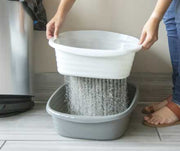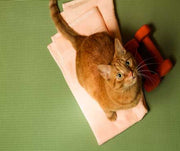How To Clean A Petmate Gravity Pet Waterer

How To Clean A Petmate Gravity Pet Waterer
Did you know that harmful bacteria's like E.Coli and Salmonella can grow in your pet's water bowl? According to multiple studies, your pet's food and water bowl can be one of the germiest things in your home. As your dog or cat eats their food and then goes to drink water, leftover crumbs can fall from their mouth's into their water bowl, leaving behind bacteria that can flourish in water.
As you may already know, dogs and cats need access to fresh water all day for their health. As a pet-parent, it's your responsibility to make sure they have access to fresh, clean water every day. However, for some people, life is busy and refilling the dog's water bowl is not always the first thing on our minds. Which is why a lot of pet parents invest in pet water fountains, also known as gravity waterers. Unfortunately, with these types of pet waterers we can easily go weeks without thinking about cleaning the water bowl because we are refilling it less often.
HOW OFTEN SHOULD I CLEAN MY PET'S WATER BOWL?
For you pet's health and well-being, you should be providing your pet with constant access to fresh, clean water. Especially during hot summer months. To keep your pet healthy, you should be cleaning out their water supply with fresh water once a day. You should clean your pet's water fountain or bowl every few days or at least once a week. If you have a standard water bowl, cleaning is easy. Just rinse and scrub with warm, soapy water and dry it completely before you refill with new water. But for some with pet gravity waterers or fountains, cleaning may be a little more of a challenge. But don't worry! Keep reading for instructions on how to clean you pet's gravity waterer fountain.
SUPPLIES YOU'LL NEED FOR CLEANING:
1. Warm water
2. A baby bottle brush
3. Soap
4. A clean, dry towel
HOW TO CLEAN YOUR PETMATE GRAVITY WATERER:
1. Separate the bottle that stores the water from the base of the fountain. This can usually be done by unscrewing or lifting the bottle from the base.
2. Unscrew the cap. Your cap may or may not have a filter strapped inside. Leave the filter alone, unless it's time to change it out. Dispose of the old water. Or water a plant with the old water if you don't want to waste!
3. Put soap on the baby bottle brush and fill the bottle with warm water. Use the brush to scrub all around the inside of the bottle like shown below:

4. Rinse out the bottle with warm water. Make sure to rinse out the bottle at least 2-3 times so that there is no leftover soap in the bottle. No dog – or cat – wants to drink soapy water. Set the bottle aside after you've rinsed.
5. Next, rinse the base with warm water. If needed, add more soap to the bottle brush.
6. Use the baby bottle brush to scrub and clean the base of the fountain. Be sure to scrub the walls and crevices of the base. Germs like to hide in these places.
7. Once you've scrubbed the entire base, rinse with warm water.
8. Last, use a clean dry towel to completely dry both the inside and outside of the bottle and the base.
Cleaning your pet's waterer once or twice a week will keep your pet hydrated, happy, and healthy. You may even notice that your pet is drinking more water. This is a good sign that they are enjoying the frequent changes and daily water changes.

As a responsible pet parent, you'll feel confident and happy knowing you're providing your pet with tasty, fresh, clean water.
Sources:
Previous article

Related posts
View all-

How to Keep Your Pet Calm During Thanksgiving
Thanksgiving is a time for family, friends, and food, but for our pets, the holiday can be overwhelming. The sudden change in routine, unfamiliar faces and scents, and increased noise can trigger significant stress. Understanding why your pet might feel anxious is the first step toward creating a peaceful holiday experience for everyone, including your furry family members. This guide offers calming tips for pets and practical solutions to ensure your dog or cat feels safe and secure during the festivities.
Read Article -

Top Travel Essentials for Pets This Holiday Season
Holiday travel often means bringing the whole family along, and for many of us, that includes our furry companions. Preparing for holiday pet travel is about more than just packing a bag; it's about ensuring your pet's safety, comfort, and happiness from the moment you leave home until you return. A little planning helps reduce stress for both you and your pet, making the journey a positive experience for everyone involved.
Read Article -

Best Leashes and Collars for Daily Walks: A Pet Parent’s Guide
A daily walk with your dog isn't just a chore—it's a chance to bond, explore, and stay active together. The right leash and collar can make every walk safer and more enjoyable for both of you. With numerous styles and materials available, it's essential to find gear that suits your dog's needs and your lifestyle.
Read Article




